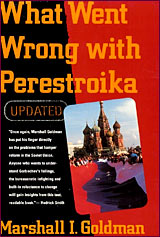 Dramatic
and confusing changes in what used to be the Soviet Union have
transformed the world in which we live. Dramatic
and confusing changes in what used to be the Soviet Union have
transformed the world in which we live.
Russia's economic situation has deteriorated since the beginning
of Gorbachev's Perestroyka,
which announced moving from centrally planned economy to a market
economy.
The absence of a clear economical doctrine and means
led to destruction of internal economical structure and declining
of industries.
 In
its turn, it led to significant raise of unemployment, with
unofficial estimates about 9-10%. Russian health and education
systems, which used to be of the highest standard during the
Soviet times, were slowly deteriorating. Inflation, started
in 1992, reached its peak in 1994, and increased 10 000% by
the end of 1997. In 1998 the government implemented a 1000%
denomination of national currency (Ruble), turned back prices
from thousands rubles to rubles. In
its turn, it led to significant raise of unemployment, with
unofficial estimates about 9-10%. Russian health and education
systems, which used to be of the highest standard during the
Soviet times, were slowly deteriorating. Inflation, started
in 1992, reached its peak in 1994, and increased 10 000% by
the end of 1997. In 1998 the government implemented a 1000%
denomination of national currency (Ruble), turned back prices
from thousands rubles to rubles.
The Soviet Union had a planned socialist economy,
in which the central government controlled everything from production
planning and prices to distribution. The Soviet satellite states
in Eastern Europe had planned economies as well. After the breakup
of the USSR, Russian reformers were confronted with the daunting
task of building a modern capitalist economy while simultaneously
striving to create a democratic state based on effective laws
and reliable administrative structures. The collapse of Communism
in Eastern Europe in the late 1980s and the dissolution of the
Soviet Union at the end of 1991 disrupted the close economic
relations Russia had previously enjoyed with neighboring Communist
states and other Soviet republics.
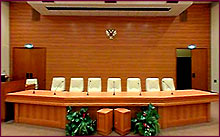 Political
turmoil and uncertainty inside the Russian government also contributed
to the country’s economic woes. Compared with most of the
former planned economies of Eastern Europe, Russia experienced
an unusually severe and protracted drop in officially reported
economic output. Political
turmoil and uncertainty inside the Russian government also contributed
to the country’s economic woes. Compared with most of the
former planned economies of Eastern Europe, Russia experienced
an unusually severe and protracted drop in officially reported
economic output.
Domestic policy in the Gorbachev
era was conducted primarily under three programs, whose names
became household words: perestroika (rebuilding), glasnost
(public voicing), and demokratizatsiya (democratization).
The first of these was applied primarily to the economy, but
it was meant to refer to society in general. Over the course
of Soviet rule, society in the Soviet Union had grown more urbanized,
better educated, and more complex. Old methods of exhortation
and coercion were inappropriate, yet Brezhnev's government had
denied change rather than mastered it. Despite Andropov's
efforts to reintroduce some measure of discipline, the communist
superpower remained stagnant. Once Gorbachev began to call for
bolder reforms, the "acceleration" gave way to perestroika.
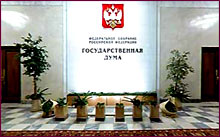 From
modest beginnings at the Twenty-Seventh Party Congress in 1986,
perestroika, Mikhail Gorbachev's program of economic, political,
and social restructuring, became the unintended catalyst for
dismantling what had taken nearly three-quarters of a century
to erect: the Marxist-Leninist-Stalinist totalitarian state. From
modest beginnings at the Twenty-Seventh Party Congress in 1986,
perestroika, Mikhail Gorbachev's program of economic, political,
and social restructuring, became the unintended catalyst for
dismantling what had taken nearly three-quarters of a century
to erect: the Marxist-Leninist-Stalinist totalitarian state.
The world watched in disbelief but with growing admiration
as Soviet forces withdrew from Afghanistan, democratic governments
overturned Communist regimes in Eastern Europe, Germany was
reunited, the Warsaw Pact withered away, and the Cold War
came to an abrupt end.
In the Soviet Union itself, however, reactions to
the new policies were mixed. Reform policies rocked the foundation
of entrenched traditional power bases in the party, economy,
and society but did not replace them entirely. Newfound freedoms
of assembly, speech, and religion, the right to strike, and
multicandidate elections undermined not only the Soviet Union's
authoritarian structures, but also the familiar sense of order
and predictability. Long-suppressed, bitter inter-ethnic,
economic, and social grievances led to clashes, strikes, and
growing crime rates.
Gorbachev introduced policies designed to begin establishing
a market economy by encouraging limited private ownership
and profitability in Soviet industry and agriculture. But
the Communist control system and over-centralization of power
and privilege were maintained and new policies produced no
economic miracles. Instead, lines got longer for scarce goods
in the stores, civic unrest mounted, and bloody crackdowns
claimed lives, particularly in the restive nationalist populations
of the outlying Caucasus and Baltic states.
On August 19, 1991, conservative elements in Gorbachev's
own administration launched an abortive coup to prevent the
signing of a new union treaty the following day and to restore
the party's power and authority. Boris Yeltsin, who had become
Russia's first popularly elected president in June 1991, made
the seat of government of his Russian republic, known as the
White House, the rallying point for resistance to the organizers
of the coup. Under his leadership, Russia embarked on even more
far - reaching reforms as the Soviet Union broke up into its
constituent republics and formed the Commonwealth of Independent
States.


|
|
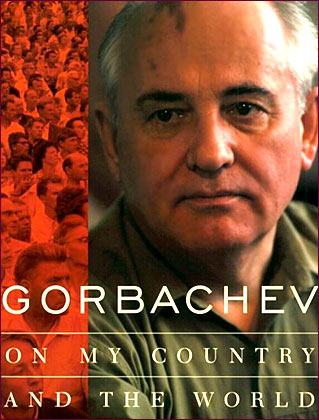
|

|
|
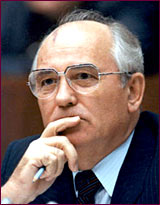 Radical
Reforms Radical
Reforms
On 11 March 1985, 54-year-old Mikhail Gorbachev was
elected the new general secretary of the Communist Party.
Following in the footsteps of such past rulers as Ivan
the Terrible, Peter the Great,
Stalin, and Brezhnev, Gorbachev
inherited a stagnating economy, an entrenched bureaucracy,
and a population that had lived in fear and mistrust of their
previous leaders. Gorbachev's first actions were to shut down
the production and sale of vodka and to ardently pursue Andropov's
anticorruption campaign; one of the first to go was Leningrad
party boss Grigory Romanov.
In 1986, when Gorbachev introduced the radical reform
policies of perestroika (restructuring), he emphasized that
past reforms hadn't worked because they didn't stress the
"involvement of the people in
modernizing and restructuring the country." Perestroika
implemented more profit motives, quality controls, private
ownership in agriculture, decentralization, and multicandidate
elections. Industry concentrated on measures promoting quality
over quantity; private businesses and cooperatives were encouraged;
farmers and individuals could now lease land and housing from
the government and keep the profits made from selling produce
grown on private plots: hundreds of ministries and bureaucratic
centers were disbanded. A law was passed that allowed individuals
to own small businesses and hire workers as long as there
was "no exploitation of man
by man." In the campaign for demokratizatsiya,
open elections were held. Glasnost let truths surface from
the Stalin and Brezhnev years.
As Peter the Great had understood,
modernization meant Westernization, and Gorbachev reopened
the window to the West. With the fostering of private
business, about five million people were employed by over
150,000 cooperatives. After 1 April 1989, all enterprises
were allowed to carry on trade relations with foreign partners.
This triggered the development of joint ventures. Multimillion
dollar deals were established with Western companies such
as Chevron, PepsiCo, Eastman-Kodak, McDonnell's, Time-Warner,
and Occidental Petroleum.
At the 1986 Iceland Summit, Gorbachev proposed to
sharply reduce the Soviet stockpile of ballistic missiles.
In December 1987, Gorbachev and US President Ronald Regain
signed a treaty at the Washington Summit to eliminate intermediate
nuclear missiles. "I do think
the winter of mistrust is over," declared
Premier Nikolai Ryzhkov.
During a visit to Finland in October 1989, Gorbachev
declared that "the Soviet Union
has no moral or political right to interfere in the affairs
of its East European neighbors. They have the right to decide
their own fate." By the end of 1989, every
country throughout Eastern Europe saw its people protesting
openly for mass reforms; not in this century had there been
such sweeping political change. The Iron Curtain crumbled,
symbolized most poignantly by the demolishing of the wall
between East and West Berlin.
In December 1989, Gorbachev met with US President George
Bush at the Malta Summit, where the two agreed that "the
arms race, mistrust, psychological and ideological struggle
should all be things of the past."
Article
about Perestroika, article
"Gorbachev and Perestroika".
|
|



